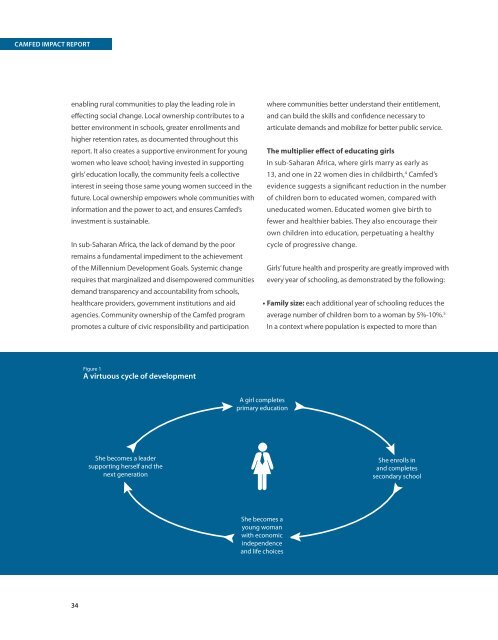Download 2010 Camfed Impact Report PDF - United Nations Girls ...
Download 2010 Camfed Impact Report PDF - United Nations Girls ...
Download 2010 Camfed Impact Report PDF - United Nations Girls ...
Create successful ePaper yourself
Turn your PDF publications into a flip-book with our unique Google optimized e-Paper software.
CAMFED IMPACT REPORT<br />
enabling rural communities to play the leading role in<br />
effecting social change. Local ownership contributes to a<br />
better environment in schools, greater enrollments and<br />
higher retention rates, as documented throughout this<br />
report. It also creates a supportive environment for young<br />
women who leave school; having invested in supporting<br />
girls’ education locally, the community feels a collective<br />
interest in seeing those same young women succeed in the<br />
future. Local ownership empowers whole communities with<br />
information and the power to act, and ensures <strong>Camfed</strong>’s<br />
investment is sustainable.<br />
In sub-Saharan Africa, the lack of demand by the poor<br />
remains a fundamental impediment to the achievement<br />
of the Millennium Development Goals. Systemic change<br />
requires that marginalized and disempowered communities<br />
demand transparency and accountability from schools,<br />
healthcare providers, government institutions and aid<br />
agencies. Community ownership of the <strong>Camfed</strong> program<br />
promotes a culture of civic responsibility and participation<br />
where communities better understand their entitlement,<br />
and can build the skills and confidence necessary to<br />
articulate demands and mobilize for better public service.<br />
The multiplier effect of educating girls<br />
In sub-Saharan Africa, where girls marry as early as<br />
13, and one in 22 women dies in childbirth, 4 <strong>Camfed</strong>’s<br />
evidence suggests a significant reduction in the number<br />
of children born to educated women, compared with<br />
uneducated women. Educated women give birth to<br />
fewer and healthier babies. They also encourage their<br />
own children into education, perpetuating a healthy<br />
cycle of progressive change.<br />
<strong>Girls</strong>’ future health and prosperity are greatly improved with<br />
every year of schooling, as demonstrated by the following:<br />
• Family size: each additional year of schooling reduces the<br />
average number of children born to a woman by 5%-10%. 5<br />
In a context where population is expected to more than<br />
Figure 1<br />
A virtuous cycle of development<br />
A girl completes<br />
primary education<br />
She becomes a leader<br />
supporting herself and the<br />
next generation<br />
She enrolls in<br />
and completes<br />
secondary school<br />
She becomes a<br />
young woman<br />
with economic<br />
independence<br />
and life choices<br />
34
















